Managing Strategic Change: Overcoming Resistance at Tesco PLC
VerifiedAdded on 2023/06/15
|8
|2198
|148
Essay
AI Summary
This essay explores strategic change management within organizations, using Tesco PLC as a case study. It discusses the importance of adapting to a dynamic environment and the challenges of overcoming resistance to change, particularly focusing on the introduction of self-checkout machines. The report highlights the need for effective communication, employee involvement, and training to facilitate smooth transitions. It also references the McKinsey 7S model and the application of change management theories to ensure successful implementation of strategic changes within Tesco PLC, emphasizing the importance of a well-prepared plan to minimize potential losses and maximize efficiency.
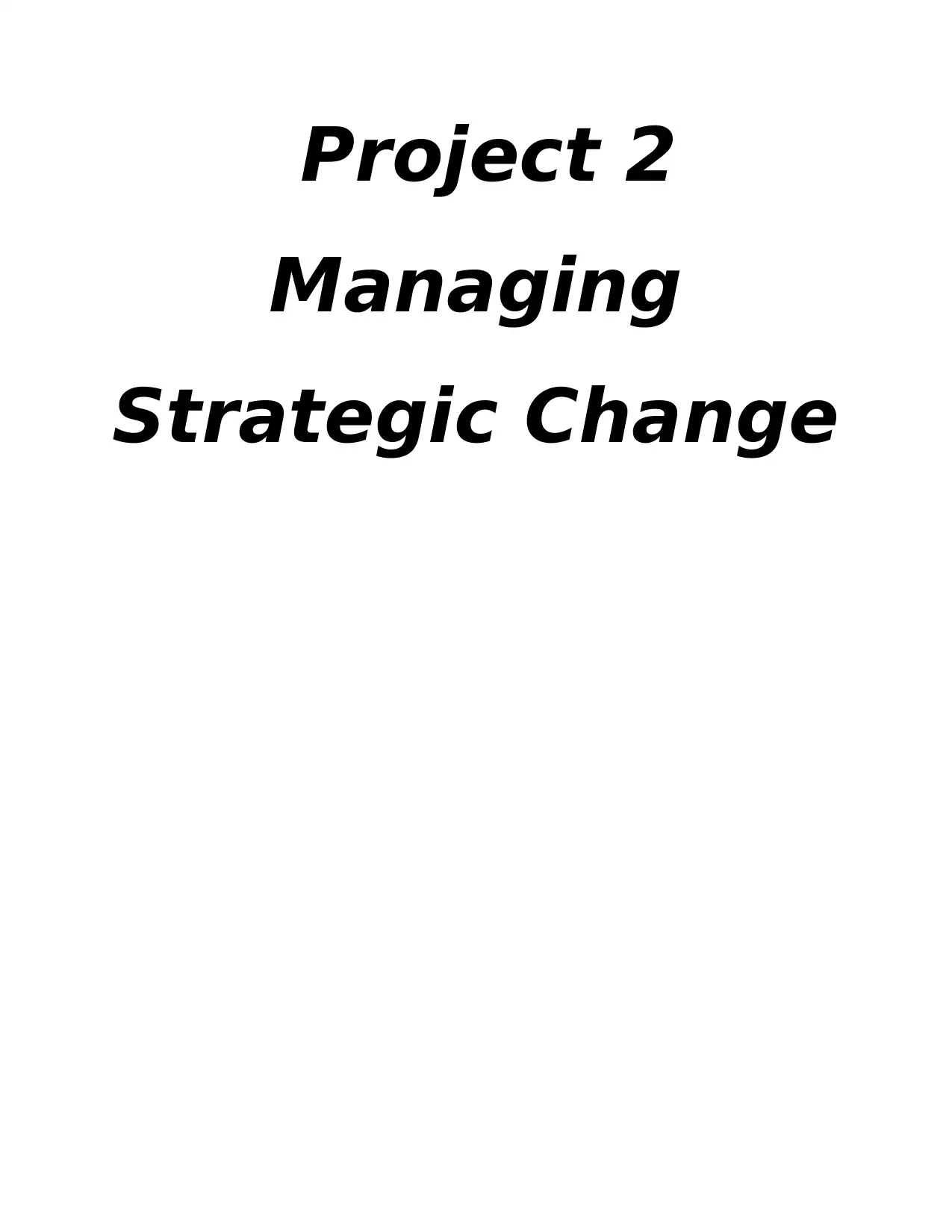
Project 2
Managing
Strategic Change
Managing
Strategic Change
Paraphrase This Document
Need a fresh take? Get an instant paraphrase of this document with our AI Paraphraser
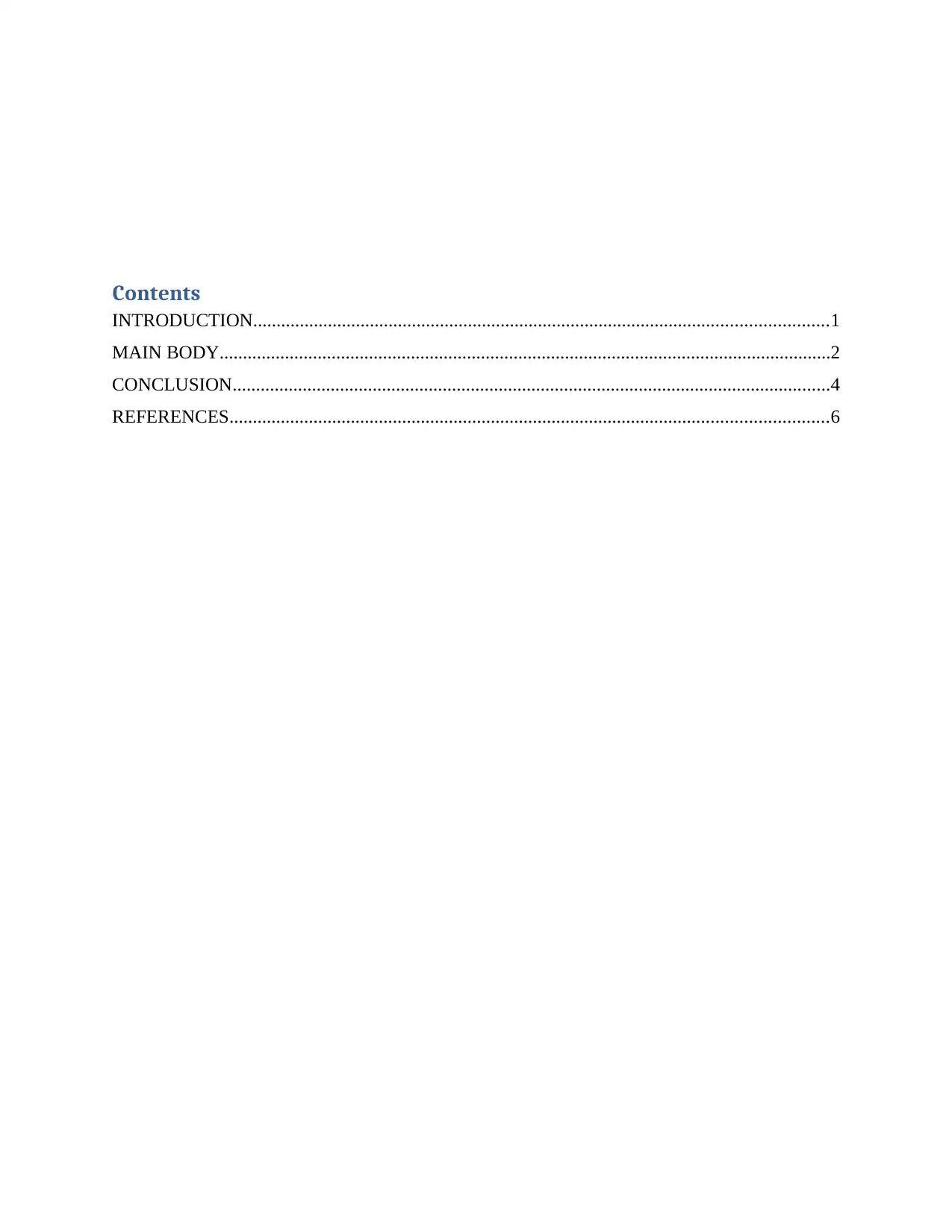
Contents
INTRODUCTION...........................................................................................................................1
MAIN BODY...................................................................................................................................2
CONCLUSION................................................................................................................................4
REFERENCES................................................................................................................................6
INTRODUCTION...........................................................................................................................1
MAIN BODY...................................................................................................................................2
CONCLUSION................................................................................................................................4
REFERENCES................................................................................................................................6
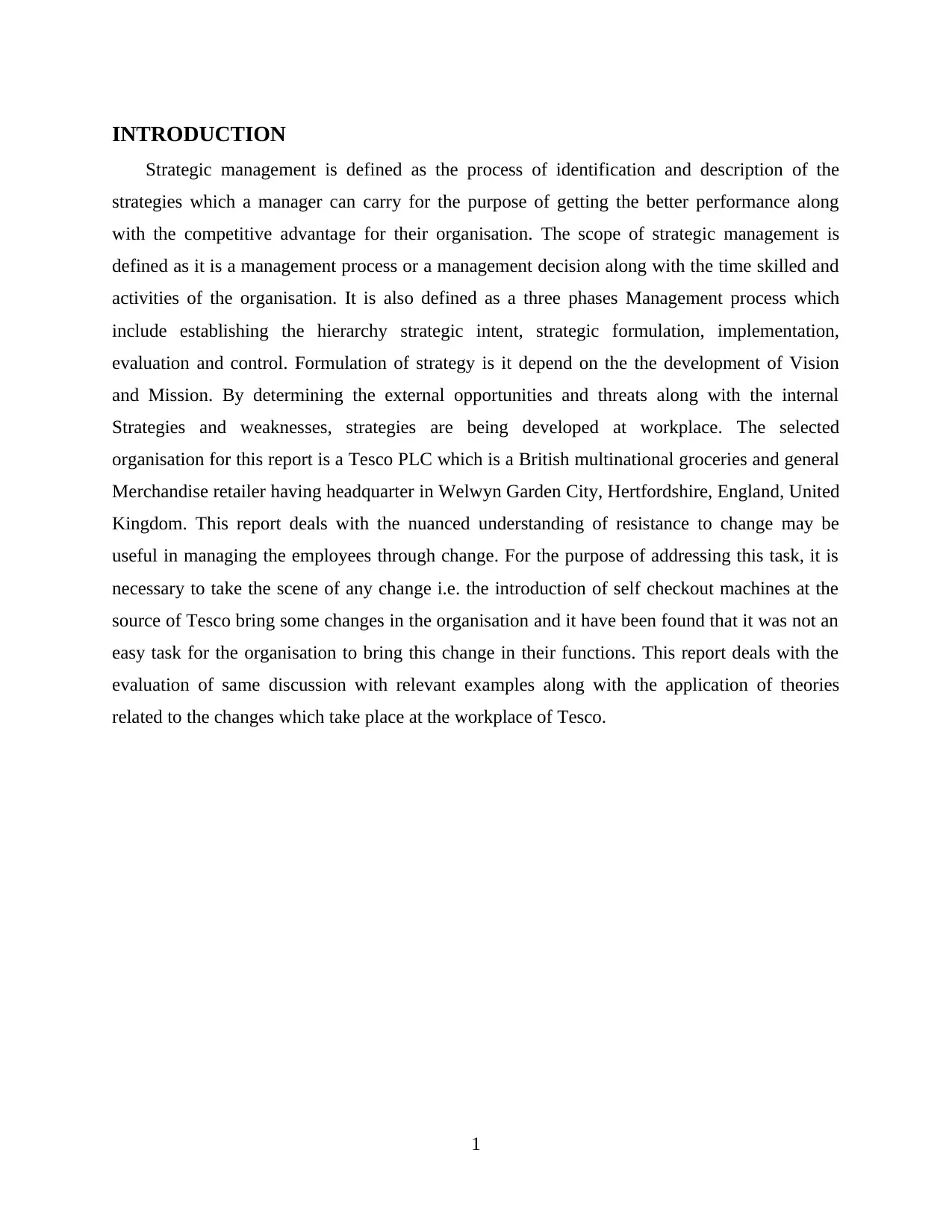
INTRODUCTION
Strategic management is defined as the process of identification and description of the
strategies which a manager can carry for the purpose of getting the better performance along
with the competitive advantage for their organisation. The scope of strategic management is
defined as it is a management process or a management decision along with the time skilled and
activities of the organisation. It is also defined as a three phases Management process which
include establishing the hierarchy strategic intent, strategic formulation, implementation,
evaluation and control. Formulation of strategy is it depend on the the development of Vision
and Mission. By determining the external opportunities and threats along with the internal
Strategies and weaknesses, strategies are being developed at workplace. The selected
organisation for this report is a Tesco PLC which is a British multinational groceries and general
Merchandise retailer having headquarter in Welwyn Garden City, Hertfordshire, England, United
Kingdom. This report deals with the nuanced understanding of resistance to change may be
useful in managing the employees through change. For the purpose of addressing this task, it is
necessary to take the scene of any change i.e. the introduction of self checkout machines at the
source of Tesco bring some changes in the organisation and it have been found that it was not an
easy task for the organisation to bring this change in their functions. This report deals with the
evaluation of same discussion with relevant examples along with the application of theories
related to the changes which take place at the workplace of Tesco.
1
Strategic management is defined as the process of identification and description of the
strategies which a manager can carry for the purpose of getting the better performance along
with the competitive advantage for their organisation. The scope of strategic management is
defined as it is a management process or a management decision along with the time skilled and
activities of the organisation. It is also defined as a three phases Management process which
include establishing the hierarchy strategic intent, strategic formulation, implementation,
evaluation and control. Formulation of strategy is it depend on the the development of Vision
and Mission. By determining the external opportunities and threats along with the internal
Strategies and weaknesses, strategies are being developed at workplace. The selected
organisation for this report is a Tesco PLC which is a British multinational groceries and general
Merchandise retailer having headquarter in Welwyn Garden City, Hertfordshire, England, United
Kingdom. This report deals with the nuanced understanding of resistance to change may be
useful in managing the employees through change. For the purpose of addressing this task, it is
necessary to take the scene of any change i.e. the introduction of self checkout machines at the
source of Tesco bring some changes in the organisation and it have been found that it was not an
easy task for the organisation to bring this change in their functions. This report deals with the
evaluation of same discussion with relevant examples along with the application of theories
related to the changes which take place at the workplace of Tesco.
1
⊘ This is a preview!⊘
Do you want full access?
Subscribe today to unlock all pages.

Trusted by 1+ million students worldwide
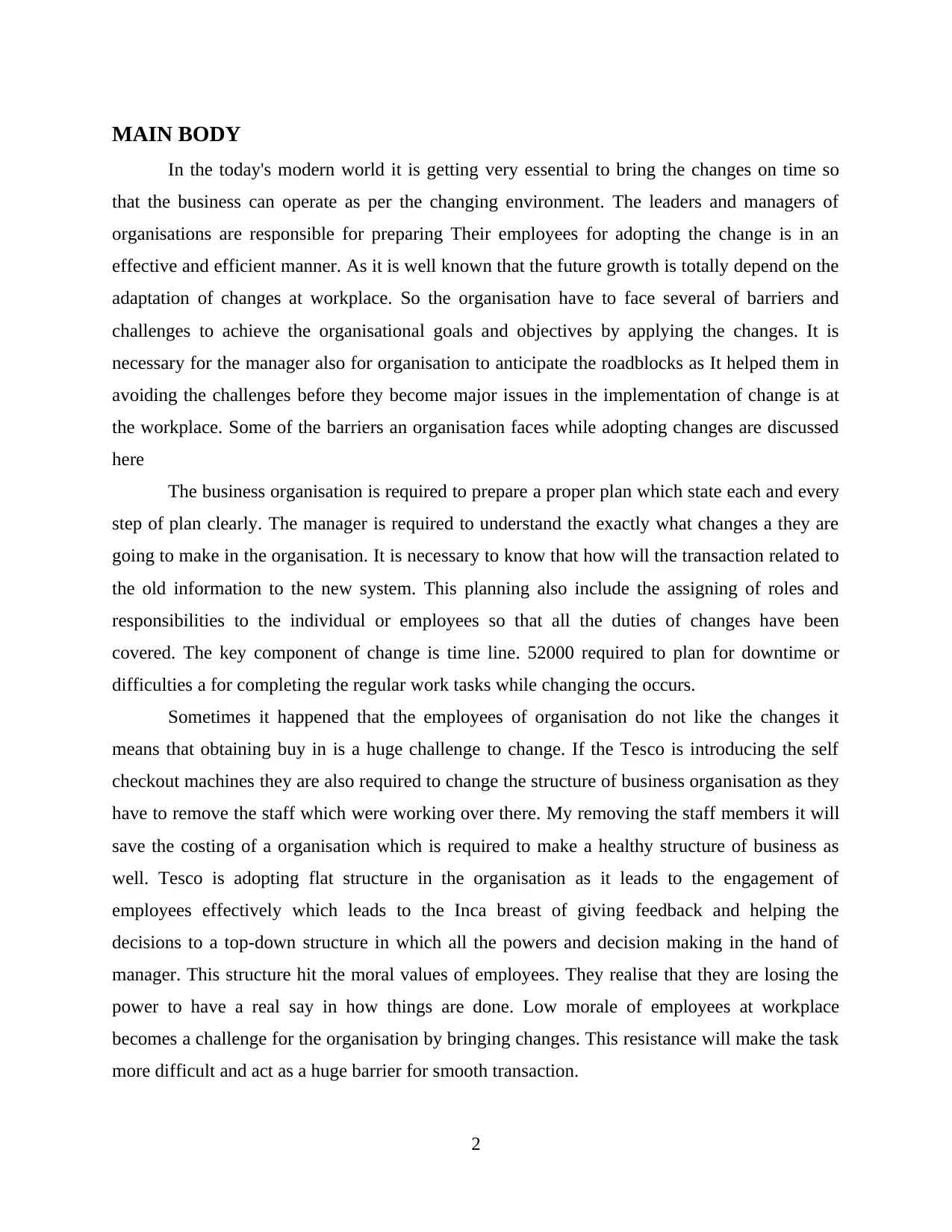
MAIN BODY
In the today's modern world it is getting very essential to bring the changes on time so
that the business can operate as per the changing environment. The leaders and managers of
organisations are responsible for preparing Their employees for adopting the change is in an
effective and efficient manner. As it is well known that the future growth is totally depend on the
adaptation of changes at workplace. So the organisation have to face several of barriers and
challenges to achieve the organisational goals and objectives by applying the changes. It is
necessary for the manager also for organisation to anticipate the roadblocks as It helped them in
avoiding the challenges before they become major issues in the implementation of change is at
the workplace. Some of the barriers an organisation faces while adopting changes are discussed
here
The business organisation is required to prepare a proper plan which state each and every
step of plan clearly. The manager is required to understand the exactly what changes a they are
going to make in the organisation. It is necessary to know that how will the transaction related to
the old information to the new system. This planning also include the assigning of roles and
responsibilities to the individual or employees so that all the duties of changes have been
covered. The key component of change is time line. 52000 required to plan for downtime or
difficulties a for completing the regular work tasks while changing the occurs.
Sometimes it happened that the employees of organisation do not like the changes it
means that obtaining buy in is a huge challenge to change. If the Tesco is introducing the self
checkout machines they are also required to change the structure of business organisation as they
have to remove the staff which were working over there. My removing the staff members it will
save the costing of a organisation which is required to make a healthy structure of business as
well. Tesco is adopting flat structure in the organisation as it leads to the engagement of
employees effectively which leads to the Inca breast of giving feedback and helping the
decisions to a top-down structure in which all the powers and decision making in the hand of
manager. This structure hit the moral values of employees. They realise that they are losing the
power to have a real say in how things are done. Low morale of employees at workplace
becomes a challenge for the organisation by bringing changes. This resistance will make the task
more difficult and act as a huge barrier for smooth transaction.
2
In the today's modern world it is getting very essential to bring the changes on time so
that the business can operate as per the changing environment. The leaders and managers of
organisations are responsible for preparing Their employees for adopting the change is in an
effective and efficient manner. As it is well known that the future growth is totally depend on the
adaptation of changes at workplace. So the organisation have to face several of barriers and
challenges to achieve the organisational goals and objectives by applying the changes. It is
necessary for the manager also for organisation to anticipate the roadblocks as It helped them in
avoiding the challenges before they become major issues in the implementation of change is at
the workplace. Some of the barriers an organisation faces while adopting changes are discussed
here
The business organisation is required to prepare a proper plan which state each and every
step of plan clearly. The manager is required to understand the exactly what changes a they are
going to make in the organisation. It is necessary to know that how will the transaction related to
the old information to the new system. This planning also include the assigning of roles and
responsibilities to the individual or employees so that all the duties of changes have been
covered. The key component of change is time line. 52000 required to plan for downtime or
difficulties a for completing the regular work tasks while changing the occurs.
Sometimes it happened that the employees of organisation do not like the changes it
means that obtaining buy in is a huge challenge to change. If the Tesco is introducing the self
checkout machines they are also required to change the structure of business organisation as they
have to remove the staff which were working over there. My removing the staff members it will
save the costing of a organisation which is required to make a healthy structure of business as
well. Tesco is adopting flat structure in the organisation as it leads to the engagement of
employees effectively which leads to the Inca breast of giving feedback and helping the
decisions to a top-down structure in which all the powers and decision making in the hand of
manager. This structure hit the moral values of employees. They realise that they are losing the
power to have a real say in how things are done. Low morale of employees at workplace
becomes a challenge for the organisation by bringing changes. This resistance will make the task
more difficult and act as a huge barrier for smooth transaction.
2
Paraphrase This Document
Need a fresh take? Get an instant paraphrase of this document with our AI Paraphraser
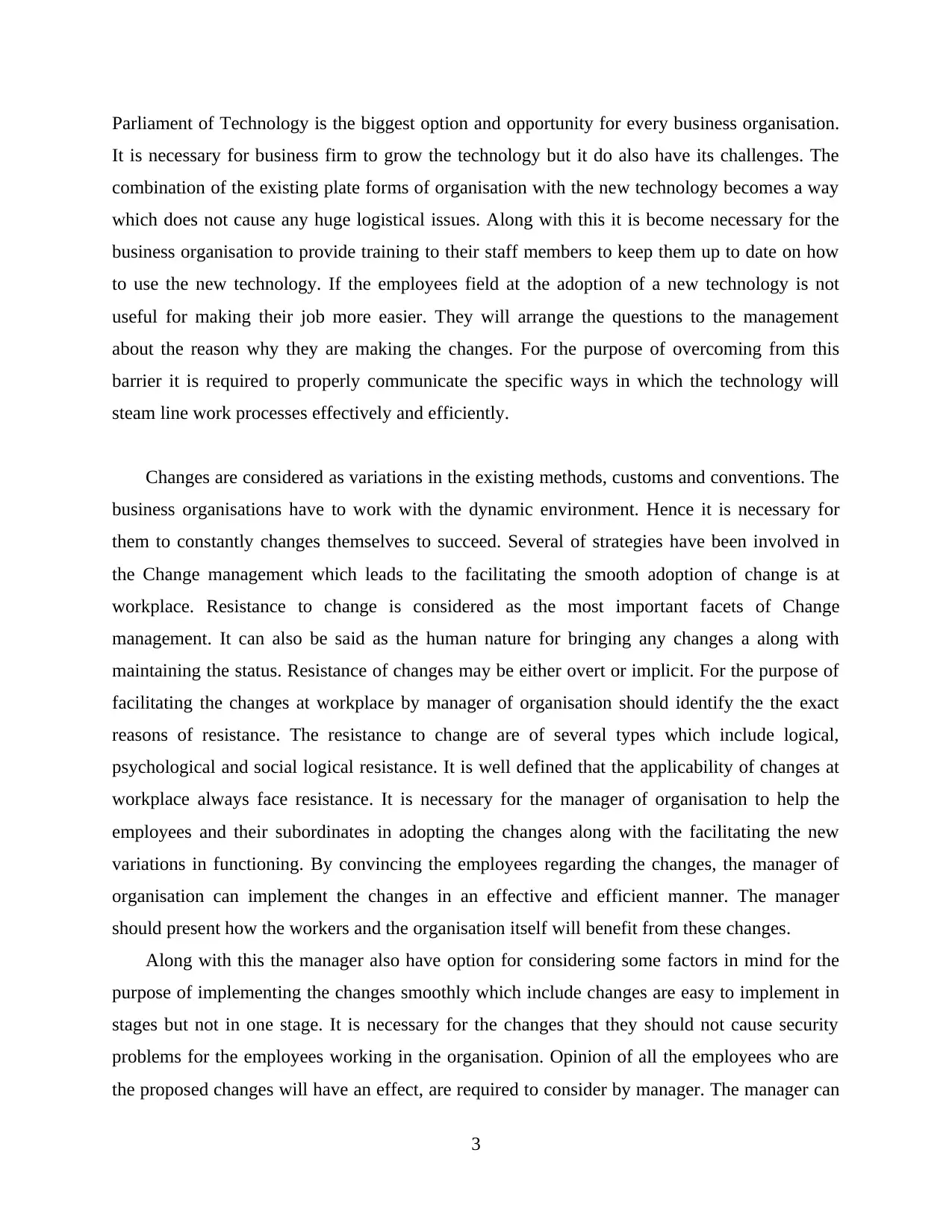
Parliament of Technology is the biggest option and opportunity for every business organisation.
It is necessary for business firm to grow the technology but it do also have its challenges. The
combination of the existing plate forms of organisation with the new technology becomes a way
which does not cause any huge logistical issues. Along with this it is become necessary for the
business organisation to provide training to their staff members to keep them up to date on how
to use the new technology. If the employees field at the adoption of a new technology is not
useful for making their job more easier. They will arrange the questions to the management
about the reason why they are making the changes. For the purpose of overcoming from this
barrier it is required to properly communicate the specific ways in which the technology will
steam line work processes effectively and efficiently.
Changes are considered as variations in the existing methods, customs and conventions. The
business organisations have to work with the dynamic environment. Hence it is necessary for
them to constantly changes themselves to succeed. Several of strategies have been involved in
the Change management which leads to the facilitating the smooth adoption of change is at
workplace. Resistance to change is considered as the most important facets of Change
management. It can also be said as the human nature for bringing any changes a along with
maintaining the status. Resistance of changes may be either overt or implicit. For the purpose of
facilitating the changes at workplace by manager of organisation should identify the the exact
reasons of resistance. The resistance to change are of several types which include logical,
psychological and social logical resistance. It is well defined that the applicability of changes at
workplace always face resistance. It is necessary for the manager of organisation to help the
employees and their subordinates in adopting the changes along with the facilitating the new
variations in functioning. By convincing the employees regarding the changes, the manager of
organisation can implement the changes in an effective and efficient manner. The manager
should present how the workers and the organisation itself will benefit from these changes.
Along with this the manager also have option for considering some factors in mind for the
purpose of implementing the changes smoothly which include changes are easy to implement in
stages but not in one stage. It is necessary for the changes that they should not cause security
problems for the employees working in the organisation. Opinion of all the employees who are
the proposed changes will have an effect, are required to consider by manager. The manager can
3
It is necessary for business firm to grow the technology but it do also have its challenges. The
combination of the existing plate forms of organisation with the new technology becomes a way
which does not cause any huge logistical issues. Along with this it is become necessary for the
business organisation to provide training to their staff members to keep them up to date on how
to use the new technology. If the employees field at the adoption of a new technology is not
useful for making their job more easier. They will arrange the questions to the management
about the reason why they are making the changes. For the purpose of overcoming from this
barrier it is required to properly communicate the specific ways in which the technology will
steam line work processes effectively and efficiently.
Changes are considered as variations in the existing methods, customs and conventions. The
business organisations have to work with the dynamic environment. Hence it is necessary for
them to constantly changes themselves to succeed. Several of strategies have been involved in
the Change management which leads to the facilitating the smooth adoption of change is at
workplace. Resistance to change is considered as the most important facets of Change
management. It can also be said as the human nature for bringing any changes a along with
maintaining the status. Resistance of changes may be either overt or implicit. For the purpose of
facilitating the changes at workplace by manager of organisation should identify the the exact
reasons of resistance. The resistance to change are of several types which include logical,
psychological and social logical resistance. It is well defined that the applicability of changes at
workplace always face resistance. It is necessary for the manager of organisation to help the
employees and their subordinates in adopting the changes along with the facilitating the new
variations in functioning. By convincing the employees regarding the changes, the manager of
organisation can implement the changes in an effective and efficient manner. The manager
should present how the workers and the organisation itself will benefit from these changes.
Along with this the manager also have option for considering some factors in mind for the
purpose of implementing the changes smoothly which include changes are easy to implement in
stages but not in one stage. It is necessary for the changes that they should not cause security
problems for the employees working in the organisation. Opinion of all the employees who are
the proposed changes will have an effect, are required to consider by manager. The manager can
3
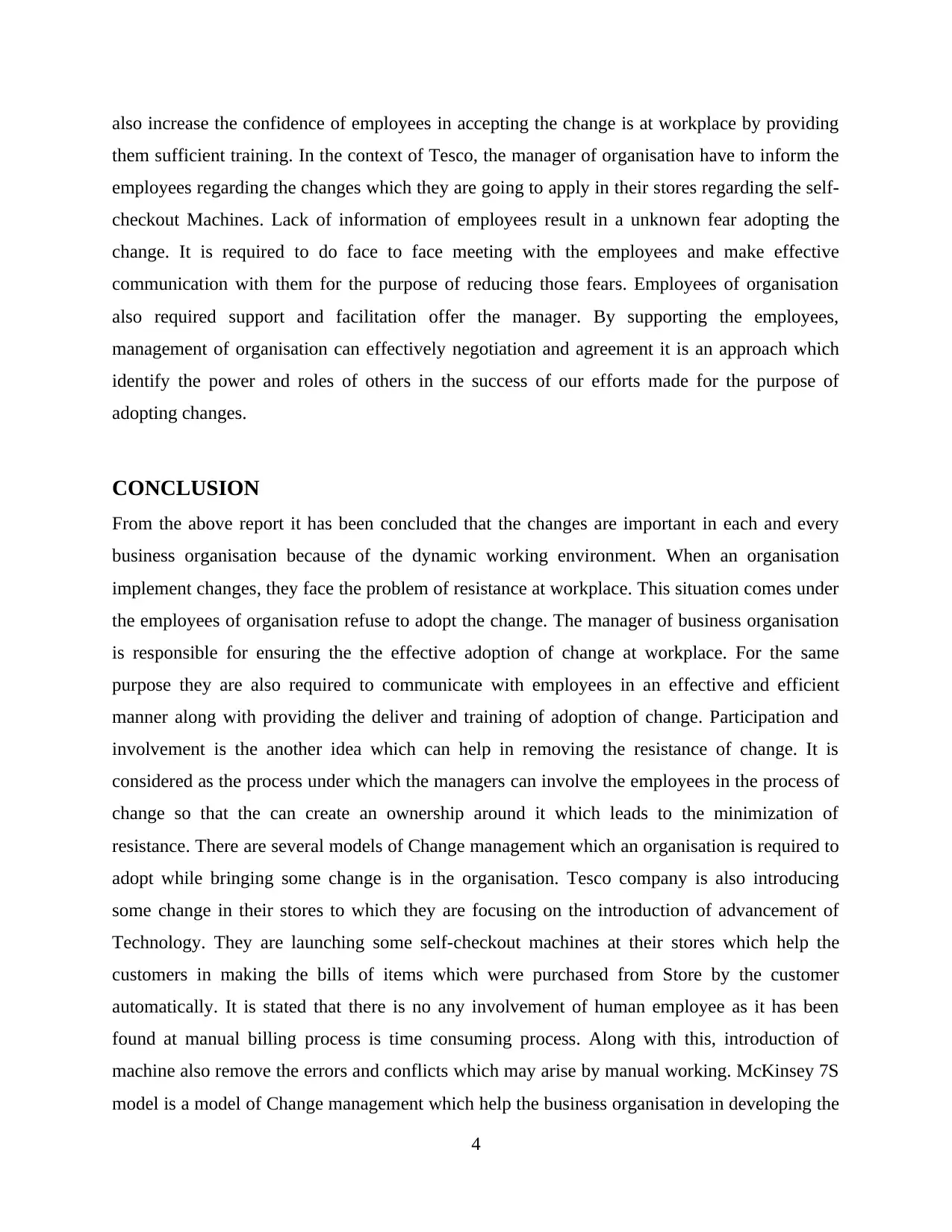
also increase the confidence of employees in accepting the change is at workplace by providing
them sufficient training. In the context of Tesco, the manager of organisation have to inform the
employees regarding the changes which they are going to apply in their stores regarding the self-
checkout Machines. Lack of information of employees result in a unknown fear adopting the
change. It is required to do face to face meeting with the employees and make effective
communication with them for the purpose of reducing those fears. Employees of organisation
also required support and facilitation offer the manager. By supporting the employees,
management of organisation can effectively negotiation and agreement it is an approach which
identify the power and roles of others in the success of our efforts made for the purpose of
adopting changes.
CONCLUSION
From the above report it has been concluded that the changes are important in each and every
business organisation because of the dynamic working environment. When an organisation
implement changes, they face the problem of resistance at workplace. This situation comes under
the employees of organisation refuse to adopt the change. The manager of business organisation
is responsible for ensuring the the effective adoption of change at workplace. For the same
purpose they are also required to communicate with employees in an effective and efficient
manner along with providing the deliver and training of adoption of change. Participation and
involvement is the another idea which can help in removing the resistance of change. It is
considered as the process under which the managers can involve the employees in the process of
change so that the can create an ownership around it which leads to the minimization of
resistance. There are several models of Change management which an organisation is required to
adopt while bringing some change is in the organisation. Tesco company is also introducing
some change in their stores to which they are focusing on the introduction of advancement of
Technology. They are launching some self-checkout machines at their stores which help the
customers in making the bills of items which were purchased from Store by the customer
automatically. It is stated that there is no any involvement of human employee as it has been
found at manual billing process is time consuming process. Along with this, introduction of
machine also remove the errors and conflicts which may arise by manual working. McKinsey 7S
model is a model of Change management which help the business organisation in developing the
4
them sufficient training. In the context of Tesco, the manager of organisation have to inform the
employees regarding the changes which they are going to apply in their stores regarding the self-
checkout Machines. Lack of information of employees result in a unknown fear adopting the
change. It is required to do face to face meeting with the employees and make effective
communication with them for the purpose of reducing those fears. Employees of organisation
also required support and facilitation offer the manager. By supporting the employees,
management of organisation can effectively negotiation and agreement it is an approach which
identify the power and roles of others in the success of our efforts made for the purpose of
adopting changes.
CONCLUSION
From the above report it has been concluded that the changes are important in each and every
business organisation because of the dynamic working environment. When an organisation
implement changes, they face the problem of resistance at workplace. This situation comes under
the employees of organisation refuse to adopt the change. The manager of business organisation
is responsible for ensuring the the effective adoption of change at workplace. For the same
purpose they are also required to communicate with employees in an effective and efficient
manner along with providing the deliver and training of adoption of change. Participation and
involvement is the another idea which can help in removing the resistance of change. It is
considered as the process under which the managers can involve the employees in the process of
change so that the can create an ownership around it which leads to the minimization of
resistance. There are several models of Change management which an organisation is required to
adopt while bringing some change is in the organisation. Tesco company is also introducing
some change in their stores to which they are focusing on the introduction of advancement of
Technology. They are launching some self-checkout machines at their stores which help the
customers in making the bills of items which were purchased from Store by the customer
automatically. It is stated that there is no any involvement of human employee as it has been
found at manual billing process is time consuming process. Along with this, introduction of
machine also remove the errors and conflicts which may arise by manual working. McKinsey 7S
model is a model of Change management which help the business organisation in developing the
4
⊘ This is a preview!⊘
Do you want full access?
Subscribe today to unlock all pages.

Trusted by 1+ million students worldwide
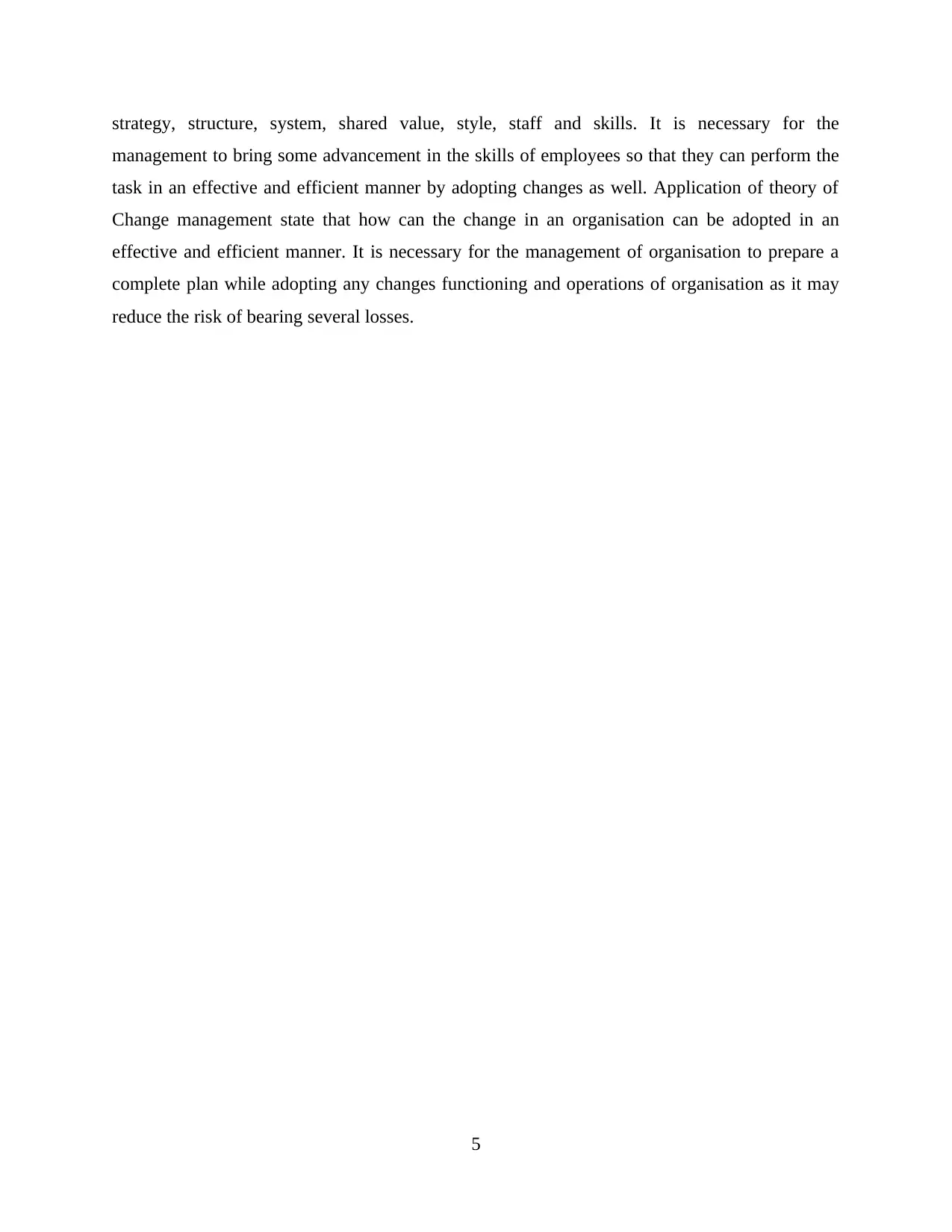
strategy, structure, system, shared value, style, staff and skills. It is necessary for the
management to bring some advancement in the skills of employees so that they can perform the
task in an effective and efficient manner by adopting changes as well. Application of theory of
Change management state that how can the change in an organisation can be adopted in an
effective and efficient manner. It is necessary for the management of organisation to prepare a
complete plan while adopting any changes functioning and operations of organisation as it may
reduce the risk of bearing several losses.
5
management to bring some advancement in the skills of employees so that they can perform the
task in an effective and efficient manner by adopting changes as well. Application of theory of
Change management state that how can the change in an organisation can be adopted in an
effective and efficient manner. It is necessary for the management of organisation to prepare a
complete plan while adopting any changes functioning and operations of organisation as it may
reduce the risk of bearing several losses.
5
Paraphrase This Document
Need a fresh take? Get an instant paraphrase of this document with our AI Paraphraser
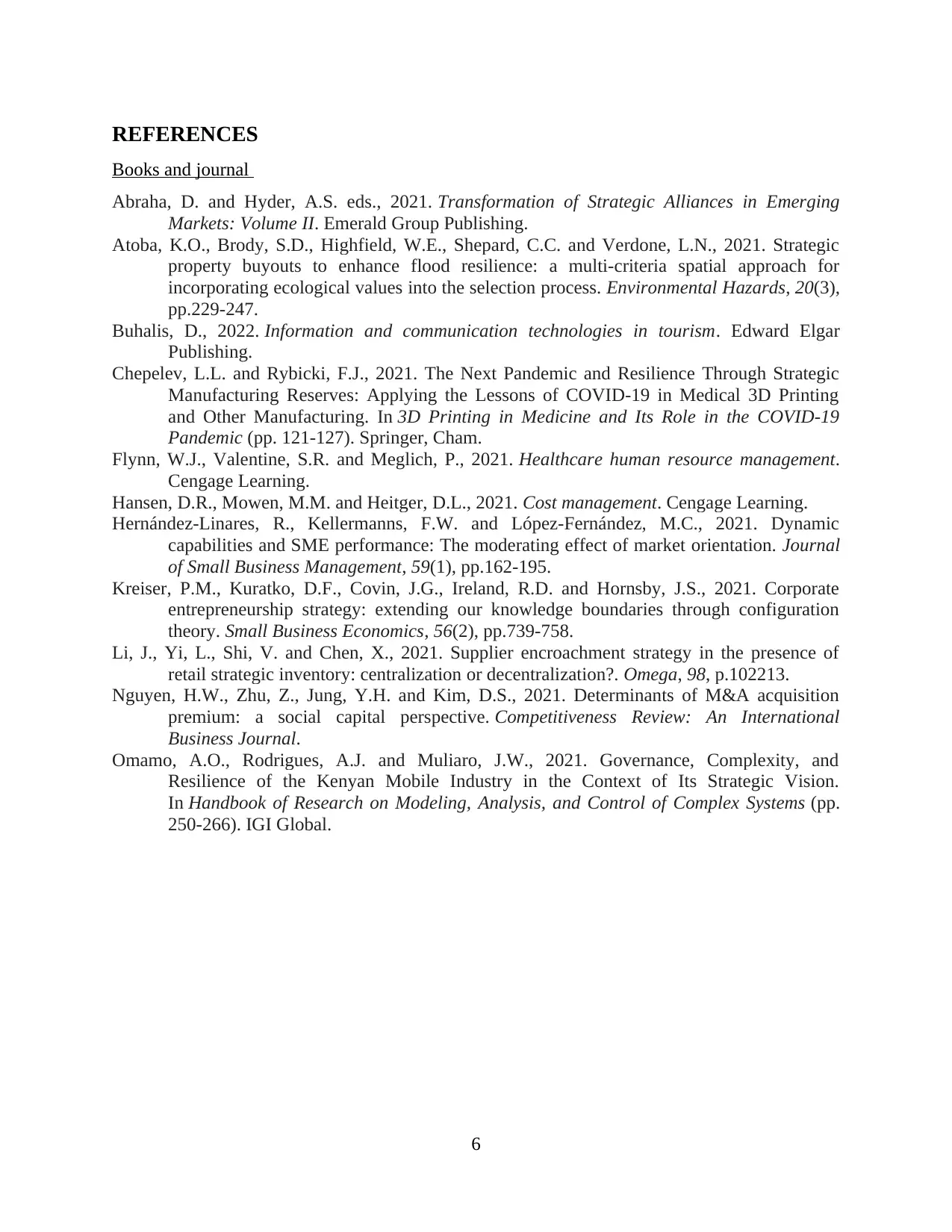
REFERENCES
Books and journal
Abraha, D. and Hyder, A.S. eds., 2021. Transformation of Strategic Alliances in Emerging
Markets: Volume II. Emerald Group Publishing.
Atoba, K.O., Brody, S.D., Highfield, W.E., Shepard, C.C. and Verdone, L.N., 2021. Strategic
property buyouts to enhance flood resilience: a multi-criteria spatial approach for
incorporating ecological values into the selection process. Environmental Hazards, 20(3),
pp.229-247.
Buhalis, D., 2022. Information and communication technologies in tourism. Edward Elgar
Publishing.
Chepelev, L.L. and Rybicki, F.J., 2021. The Next Pandemic and Resilience Through Strategic
Manufacturing Reserves: Applying the Lessons of COVID-19 in Medical 3D Printing
and Other Manufacturing. In 3D Printing in Medicine and Its Role in the COVID-19
Pandemic (pp. 121-127). Springer, Cham.
Flynn, W.J., Valentine, S.R. and Meglich, P., 2021. Healthcare human resource management.
Cengage Learning.
Hansen, D.R., Mowen, M.M. and Heitger, D.L., 2021. Cost management. Cengage Learning.
Hernández-Linares, R., Kellermanns, F.W. and López-Fernández, M.C., 2021. Dynamic
capabilities and SME performance: The moderating effect of market orientation. Journal
of Small Business Management, 59(1), pp.162-195.
Kreiser, P.M., Kuratko, D.F., Covin, J.G., Ireland, R.D. and Hornsby, J.S., 2021. Corporate
entrepreneurship strategy: extending our knowledge boundaries through configuration
theory. Small Business Economics, 56(2), pp.739-758.
Li, J., Yi, L., Shi, V. and Chen, X., 2021. Supplier encroachment strategy in the presence of
retail strategic inventory: centralization or decentralization?. Omega, 98, p.102213.
Nguyen, H.W., Zhu, Z., Jung, Y.H. and Kim, D.S., 2021. Determinants of M&A acquisition
premium: a social capital perspective. Competitiveness Review: An International
Business Journal.
Omamo, A.O., Rodrigues, A.J. and Muliaro, J.W., 2021. Governance, Complexity, and
Resilience of the Kenyan Mobile Industry in the Context of Its Strategic Vision.
In Handbook of Research on Modeling, Analysis, and Control of Complex Systems (pp.
250-266). IGI Global.
6
Books and journal
Abraha, D. and Hyder, A.S. eds., 2021. Transformation of Strategic Alliances in Emerging
Markets: Volume II. Emerald Group Publishing.
Atoba, K.O., Brody, S.D., Highfield, W.E., Shepard, C.C. and Verdone, L.N., 2021. Strategic
property buyouts to enhance flood resilience: a multi-criteria spatial approach for
incorporating ecological values into the selection process. Environmental Hazards, 20(3),
pp.229-247.
Buhalis, D., 2022. Information and communication technologies in tourism. Edward Elgar
Publishing.
Chepelev, L.L. and Rybicki, F.J., 2021. The Next Pandemic and Resilience Through Strategic
Manufacturing Reserves: Applying the Lessons of COVID-19 in Medical 3D Printing
and Other Manufacturing. In 3D Printing in Medicine and Its Role in the COVID-19
Pandemic (pp. 121-127). Springer, Cham.
Flynn, W.J., Valentine, S.R. and Meglich, P., 2021. Healthcare human resource management.
Cengage Learning.
Hansen, D.R., Mowen, M.M. and Heitger, D.L., 2021. Cost management. Cengage Learning.
Hernández-Linares, R., Kellermanns, F.W. and López-Fernández, M.C., 2021. Dynamic
capabilities and SME performance: The moderating effect of market orientation. Journal
of Small Business Management, 59(1), pp.162-195.
Kreiser, P.M., Kuratko, D.F., Covin, J.G., Ireland, R.D. and Hornsby, J.S., 2021. Corporate
entrepreneurship strategy: extending our knowledge boundaries through configuration
theory. Small Business Economics, 56(2), pp.739-758.
Li, J., Yi, L., Shi, V. and Chen, X., 2021. Supplier encroachment strategy in the presence of
retail strategic inventory: centralization or decentralization?. Omega, 98, p.102213.
Nguyen, H.W., Zhu, Z., Jung, Y.H. and Kim, D.S., 2021. Determinants of M&A acquisition
premium: a social capital perspective. Competitiveness Review: An International
Business Journal.
Omamo, A.O., Rodrigues, A.J. and Muliaro, J.W., 2021. Governance, Complexity, and
Resilience of the Kenyan Mobile Industry in the Context of Its Strategic Vision.
In Handbook of Research on Modeling, Analysis, and Control of Complex Systems (pp.
250-266). IGI Global.
6
1 out of 8
Related Documents
Your All-in-One AI-Powered Toolkit for Academic Success.
+13062052269
info@desklib.com
Available 24*7 on WhatsApp / Email
![[object Object]](/_next/static/media/star-bottom.7253800d.svg)
Unlock your academic potential
Copyright © 2020–2025 A2Z Services. All Rights Reserved. Developed and managed by ZUCOL.





